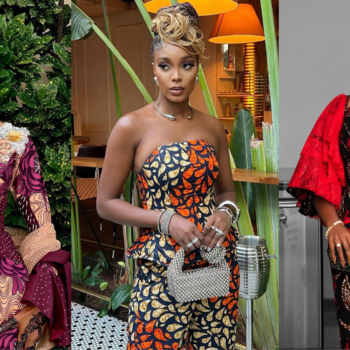The African fashion market is worth a whopping $15.5 billion! It’s an impressive figure, but here is the catch: the actual supply is worth less than a quarter of this. Most of the cash spent goes straight into the pockets of non-African brands and retailers, leaving local brands scrambling.
Take the story of Kemi, a young Nigerian designer who dreams of launching her fashion line to rival the likes of Zara and H&M. She pours her heart and soul into creating beautiful designs that blend African prints with modern cuts. Yet, despite her best efforts, her brand never takes off. What is she doing wrong? And more importantly, what can Kemi and other African fashion brands do to succeed in the highly competitive fashion market? In this piece, I will highlight the most pressing challenge many African fashion brands face and explore possible solutions to help our indigenous brands scale.

The value-creation engine
Let’s start with what powers an industry: human and physical capital. The greatest challenge Nigerian (and possibly African) fashion business owners face is inadequate physical and human capital. Nearly every Nigerian fashion brand owner I speak to cites infrastructure as a primary challenge. Many African fashion brands start out wanting to be like Zara, Primark, and H&M, with the goal of producing fast, affordable fashion for the masses. However, they quickly realise it is easier said than done. As they navigate their path to market, they encounter infrastructural limitations along the way, which cripple some and end others.
Physical and human infrastructure are two sides of the same coin. From power outages to transportation woes, African fashion brands encounter numerous physical infrastructure hurdles in bringing their products to market. However, even if all these challenges were magically solved overnight, they would face the other key obstacle to success: the lack of human capacity. While physical infrastructure is the backbone of any industry, it is people who operate the infrastructure. Without skilled people to deploy the infrastructure, it would not be maximised.
Most African fashion business owners deal with either or both sides of the infrastructure coin. In instances where they have access to physical infrastructure, like equipment and technology, they may lack the skills, knowledge, and exposure to utilise these resources effectively and struggle to create products that meet the needs of consumers. On the other hand, brands focused solely on human capacity may excel in craftsmanship and design but lack the infrastructure to scale their operations to meet demand. It is a tricky balance to strike, which is perhaps the reason no African brand has been able to create broad-based mass-market appeal. However, the intra-Africa gap between demand and supply suggests that the payoff could be huge for those who get it right.
For a more holistic view of the infrastructure challenge, it is critical to take a system-wide view of the fashion value chain in Africa. Infrastructure development is a long-term play that requires significant investment from both the public and private sectors. A business owner cannot take on a power or logistics project, nor can they singlehandedly train and deploy the talent required to achieve quality at scale. So while I would briefly highlight the long-term infrastructure plays that require significant capital outlay and external stakeholders, I will also identify some strategies African fashion brands can employ to see short-to-mid-term results.
Long term solutions
With investments in physical infrastructure to improve manufacturing facilities, logistics, and supply chain management, African fashion entrepreneurs can increase production capacity, improve product quality, and reduce lead times.
To improve human capacity in the fashion industry, we should also invest in high-quality training across the board. However, many fashion schools exclude a large portion of the labour force—the unschooled—due to the highly formal nature of their programs and baseline educational requirements. The outcomes are limited engagement, higher labour costs, and lower quality. By factoring in the unschooled population in training, we can improve matching, reduce costs, and increase productivity, leading to better product quality, innovation, and growth of local supply chains.
Similarly, fashion incubators, accelerators, and venture capital funds can provide entrepreneurs with necessary resources like finance, business support, and mentorship.
Short term solutions
In the face of infrastructure challenges, individual fashion brands can adopt strategies to minimise the impact of these challenges. One such strategy is collaboration. By working with other designers, manufacturers, and stakeholders, brands can pool their resources, share knowledge, and achieve economies of scale. I will give two examples:
- Two fashion brands with complementary products can collaborate on a collection, sharing resources such as fabric sourcing, manufacturing, and marketing efforts.
- A group of fashion brands can form a collective to share a manufacturing facility, reducing costs and ensuring the facility is used to capacity.
Another strategy is to invest in technology. From 3D printing and augmented reality to online learning, many innovative tools and platforms can help designers and manufacturers create better products, manage supply-chain, sharpen their skills, and reach new markets. Let’s take a closer look at two examples:
- Brands can invest in pattern-making software to reduce dependency on manual pattern-making skills and scale pattern-making processes.
- Brands can leverage data analytics to inform product design, production planning, and marketing, minimising the skill gaps required for these functions and reducing strain on limited infrastructure.
In conclusion, limited physical and human infrastructure hinders the growth of indigenous brands. Investments in physical and human infrastructure will help these brands deliver valuable outputs at scale. While most infrastructure development requires a significant capital outlay by external stakeholders, fashion entrepreneurs can also minimise the impact of the infrastructure challenges by collaborating and investing in technology. By pursuing these solutions, the African fashion industry can achieve its full potential, generate wealth for local brands like Kemi’s, and contribute to the continent’s economic development.




